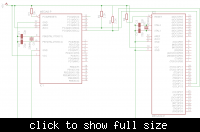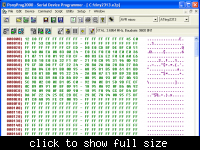bhanupriya
Newbie level 6
Can any one help me to connect two atmega8 MCs using i2c?....Actualy I'm not familiar wid dis i2c & AVR....So plz help me if u knw......
Follow along with the video below to see how to install our site as a web app on your home screen.
Note: This feature may not be available in some browsers.
Can any one help me to connect two atmega8 MCs using i2c?....Actualy I'm not familiar wid dis i2c & AVR....So plz help me if u knw......

Sorry I don't use Linux. :-(bhanupriya said:But, how to upload the program to atmega8 in linux??....(we are using parallel port for de connection.....)
Sorry, but the provided link gives me an error and I cannot open it.How leds can be connected for the communication b/t avrs in dis fig....**broken link removed** v need transducers for de communication??...if u knw plz help....
But, how to upload the program to atmega8 in linux??....(we are using parallel port for de connection.....)

The number of devices that can be connected to the bus is only limited by the bus
capacitance limit of 400 pF and the 7-bit slave address space. A detailed specification of
the electrical characteristics of the TWI is given in “Two-wire Serial Interface Character-
istics” on page 290. Two different sets of specifications are presented there, one
relevant for bus speeds below 100 kHz, and one valid for bus speeds up to 400 kHz.
https://obrazki.elektroda.pl/84_1325215544.jpg can u snd de c code(master & slave) for dis ckt?..
// Program for Master Mode
// Check Code2 for Slave Mode Program
#include<avr/io.h>
#include<util/delay.h>
#include<inttypes.h>
void TWI_start(void);
void TWI_repeated_start(void);
void TWI_init_master(void);
void TWI_write_address(unsigned char);
void TWI_read_address(unsigned char);
void TWI_write_data(unsigned char);
void TWI_read_data(void);
void TWI_stop(void);
unsigned char address=0x20, read=1, write=1;
unsigned char write_data=0x01, recv_data;
int main(void)
{
_delay_ms(2000);
DDRB=0xff;
TWI_init_master(); // Function to initialize TWI
while(1)
{
if(write_data==0x00)
write_data=1;
TWI_start(); // Function to send start condition
TWI_write_address(address+write); // Function to write address and data direction bit(write) on SDA
TWI_write_data(write_data); // Function to write data in slave
TWI_stop(); // Function to send stop condition
_delay_ms(10); // Delay of 10 mili second
TWI_start();
TWI_read_address(address+read); // Function to write address and data direction bit(read) on SDA
TWI_read_data(); // Function to read data from slave
TWI_stop();
_delay_ms(1000);
write_data = write_data * 2;
}
}
void TWI_init_master(void) // Function to initialize master
{
TWBR=0x01; // Bit rate
TWSR=(0<<TWPS1)|(0<<TWPS0); // Setting prescalar bits
// SCL freq= F_CPU/(16+2(TWBR).4^TWPS)
}
void TWI_start(void)
{
// Clear TWI interrupt flag, Put start condition on SDA, Enable TWI
TWCR= (1<<TWINT)|(1<<TWSTA)|(1<<TWEN);
while(!(TWCR & (1<<TWINT))); // Wait till start condition is transmitted
while((TWSR & 0xF8)!= 0x08); // Check for the acknowledgement
}
void TWI_repeated_start(void)
{
// Clear TWI interrupt flag, Put start condition on SDA, Enable TWI
TWCR= (1<<TWINT)|(1<<TWSTA)|(1<<TWEN);
while(!(TWCR & (1<<TWINT))); // wait till restart condition is transmitted
while((TWSR & 0xF8)!= 0x10); // Check for the acknoledgement
}
void TWI_write_address(unsigned char data)
{
TWDR=data; // Address and write instruction
TWCR=(1<<TWINT)|(1<<TWEN); // Clear TWI interrupt flag,Enable TWI
while (!(TWCR & (1<<TWINT))); // Wait till complete TWDR byte transmitted
while((TWSR & 0xF8)!= 0x18); // Check for the acknoledgement
}
void TWI_read_address(unsigned char data)
{
TWDR=data; // Address and read instruction
TWCR=(1<<TWINT)|(1<<TWEN); // Clear TWI interrupt flag,Enable TWI
while (!(TWCR & (1<<TWINT))); // Wait till complete TWDR byte received
while((TWSR & 0xF8)!= 0x40); // Check for the acknoledgement
}
void TWI_write_data(unsigned char data)
{
TWDR=data; // put data in TWDR
TWCR=(1<<TWINT)|(1<<TWEN); // Clear TWI interrupt flag,Enable TWI
while (!(TWCR & (1<<TWINT))); // Wait till complete TWDR byte transmitted
while((TWSR & 0xF8) != 0x28); // Check for the acknoledgement
}
void TWI_read_data(void)
{
TWCR=(1<<TWINT)|(1<<TWEN); // Clear TWI interrupt flag,Enable TWI
while (!(TWCR & (1<<TWINT))); // Wait till complete TWDR byte transmitted
while((TWSR & 0xF8) != 0x58); // Check for the acknoledgement
recv_data=TWDR;
PORTB=recv_data;
}
void TWI_stop(void)
{
// Clear TWI interrupt flag, Put stop condition on SDA, Enable TWI
TWCR= (1<<TWINT)|(1<<TWEN)|(1<<TWSTO);
while(!(TWCR & (1<<TWSTO))); // Wait till stop condition is transmitted
}// Program for Slave mode
#include<avr/io.h>
#include<util/delay.h>
void TWI_init_slave(void);
void TWI_match_read_slave(void);
void TWI_read_slave(void);
void TWI_match_write_slave(void);
void TWI_write_slave(void);
unsigned char write_data,recv_data;
int main(void)
{
DDRB=0xff;
TWI_init_slave(); // Function to initilaize slave
while(1)
{
TWI_match_read_slave(); //Function to match the slave address and slave dirction bit(read)
TWI_read_slave(); // Function to read data
write_data=~recv_data; // Togglem the receive data
TWI_match_write_slave(); //Function to match the slave address and slave dirction bit(write)
TWI_write_slave(); // Function to write data
}
}
void TWI_init_slave(void) // Function to initilaize slave
{
TWAR=0x20; // Fill slave address to TWAR
}
void TWI_write_slave(void) // Function to write data
{
TWDR= write_data; // Fill TWDR register whith the data to be sent
TWCR= (1<<TWEN)|(1<<TWINT); // Enable TWI, Clear TWI interrupt flag
while((TWSR & 0xF8) != 0xC0); // Wait for the acknowledgement
}
void TWI_match_write_slave(void) //Function to match the slave address and slave dirction bit(write)
{
while((TWSR & 0xF8)!= 0xA8) // Loop till correct acknoledgement have been received
{
// Get acknowlegement, Enable TWI, Clear TWI interrupt flag
TWCR=(1<<TWEA)|(1<<TWEN)|(1<<TWINT);
while (!(TWCR & (1<<TWINT))); // Wait for TWINT flag
}
}
void TWI_read_slave(void)
{
// Clear TWI interrupt flag,Get acknowlegement, Enable TWI
TWCR= (1<<TWINT)|(1<<TWEA)|(1<<TWEN);
while (!(TWCR & (1<<TWINT))); // Wait for TWINT flag
while((TWSR & 0xF8)!=0x80); // Wait for acknowledgement
recv_data=TWDR; // Get value from TWDR
PORTB=recv_data; // send the receive value on PORTB
}
void TWI_match_read_slave(void) //Function to match the slave address and slave dirction bit(read)
{
while((TWSR & 0xF8)!= 0x60) // Loop till correct acknoledgement have been received
{
// Get acknowlegement, Enable TWI, Clear TWI interrupt flag
TWCR=(1<<TWEA)|(1<<TWEN)|(1<<TWINT);
while (!(TWCR & (1<<TWINT))); // Wait for TWINT flag
}
}Oh sorry...I found that code...
But can we use 2 ATMEGA8s instead of ATMEGA32s?...If can, what change we need to implement in the code?...